YOU ARE GOING TO LOVE CARTAGENA! I can’t imagine anyone not liking the city. You may be worried about visiting this city in Colombia, but you don’t have to be. Especially if you find yourself in the Old Town Cartagena. It’s really a wonderful place, here’s why:
- Cartagena is the safest city in Colombia.
- It’s not a tourist trap. I was there November/December and although the tourists were there, it was not overcrowded like Venice.
- The locals frown on public drunkenness and are not afraid to put misbehaved tourists in their place (this is quite entertaining when it happens). This means that while you can party and have a great time, you don’t need to worry about obnoxious tourists or locals.
- It’s not Mexico. You’re not going to get sick from the food or water…unless you eat oysters at the beach…everything else is a-ok (even the super cheap ceviche). Here’s a full list of the things you need to eat in Cartagena.
Cartagena is not perfect. It has plenty of issues, but even with the negatives I left ready to go back. I’ll walk you through some of the coolest spots in the old town (there will be other blogs for other neighborhoods), and give you some tips for your trip to Cartagena Colombia (they’re at the bottom of this post – so scroll if you’re in a rush).
Old Town Cartagena Guide
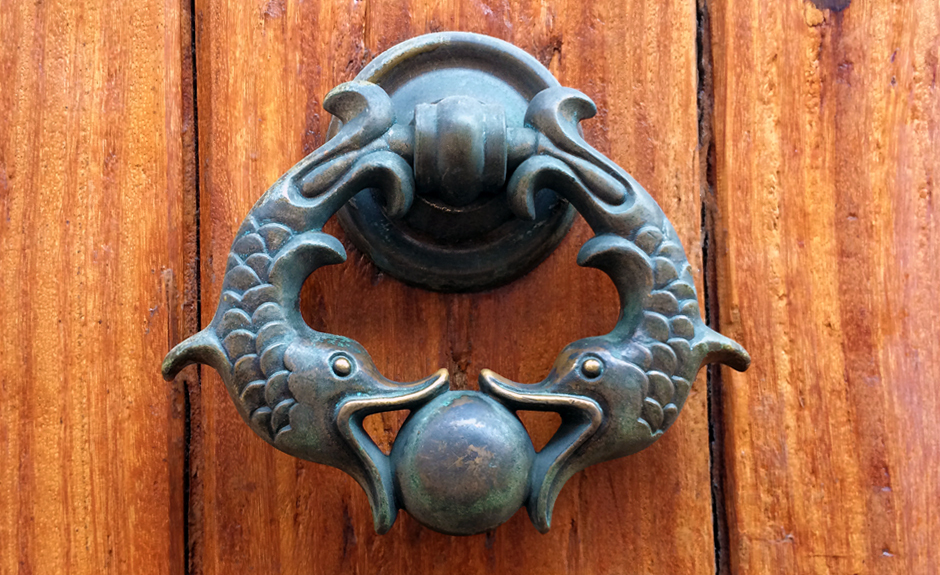
Chances are if you’re headed to Cartagena, you’ll spend most of your time in the Ciudad Vieja (the old town). This is where most tourists spend their time, and it is easy to see why. The old town and the Ciudad Murallada (walled city) is a treasure trove of Colonial architecture, churches, gorgeous mansions, amazing shopping, and history. I loved the old city and spent plenty of time there…I could have spent even more and plan to quite soon. Cartagena is a very inexpensive travel location if you do it right.
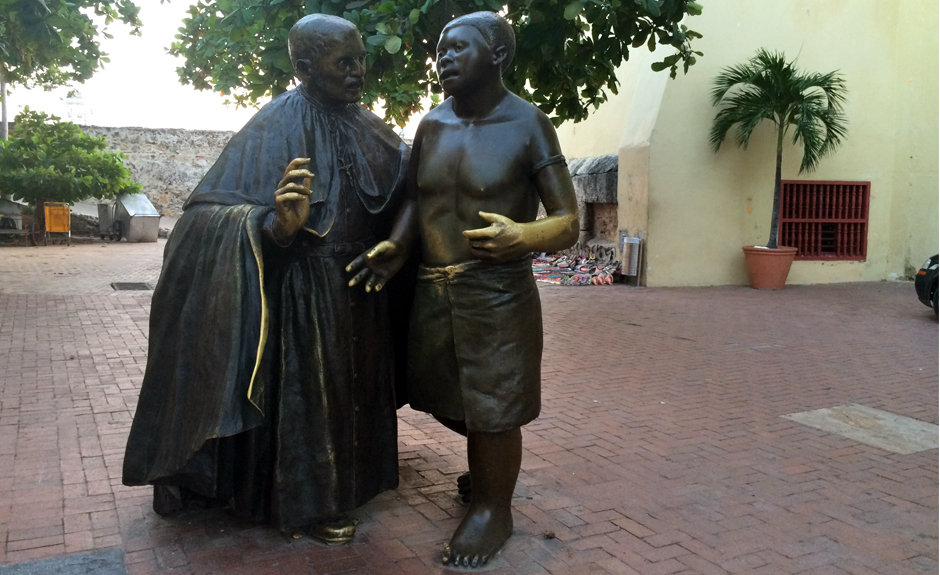
A BRIEF HISTORY OF CARTAGENA
You probably noticed if you googled “Cartagena” that a Spanish city pops up from time to time. This is the city that gave La Heroica her name, and the reason why Cartagena is known as Cartagena de Indias. Prior to the arrival of the Spanish in 1533, Cartagena was inhabited by the Karib, Malibu and Arawak. Spaniards came and took over. Cartagena’s location on the Caribbean made it an important trading post (many slaves were put to horrible fates here) and a great place for profit for the Spanish. This, in turn made it attractive to Spain’s rivals. The Spanish needed to protect themselves and built the Castillo San Felipe de Barajas. The Spanish held their ground and the Catholic church took hold of the city. Cartagena was at one point a center for the Inquisition of the Americas. In 1821 Simon Bolivar liberated the city from Spain and Cartagena’s modern history began.
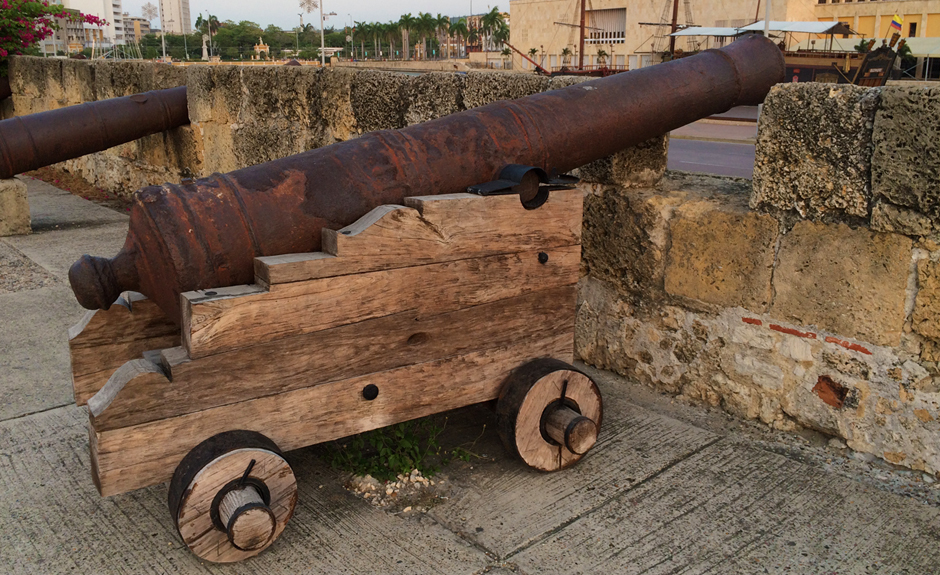
THE OLD CITY OF CARTAGENA
The old city is more than just the walled city…but it’s small enough that you can walk it all in one day night (you’ll end up heat stroked or sunburned if you attempt this during the daytime). There are three main neighborhoods in the old city: San Pedro, San Diego and Getsemani. San Pedro was where the rich people lived. San Diego was for the working people, and Getsemani has now become the hippest neighborhood after being known for being the place for prostitution. Cartagena values its travel dollars, so you should be safe all over the old city. At no point did I feel threatened and we had no bad experiences with thieves or pick pockets. There are always people on the streets and I had no issues at all. That being said, don’t be stupid and go flaunting money, cellphones, or jewelry. Have fun, but observe caution and you’ll be just fine.
WHAT TO SEE IN CARTAGENA’S OLD CITY

Plaza de San Pedro Claver (1575-1612) – You’ll know you’re there when you begin to see some charming metal sculptures of people doing what Colombian people do: getting a haircut, playing games, etc.. These were made by sculptor Eduardo Carmona. Then you will notice a large sculpture of a man of the cloth in conversation with a slave. As I mentioned before, Cartagena’s economy was boosted by the slave trade. Claver was a Spanish Jesuit priest who baptized and proselytized slaves that arrived from Africa. He considered himself the advocate for slaves and was canonized in the late 1800’s. The church dedicated to him is a Cathedral in the Italian style and totally worth a visit (especially since it’s pretty cool in there). There is also a museum where you can learn more about Cartagena’s history and the slave trade that built the city. At this plaza, you will often find Palenqueras selling fruit (perfect respite from the heat – watermelon, pineapple, papaya) and homemade sweets like cocadas. If you want to take a picture of or with a Palenquera, it is customary to make a small purchase beforehand. Heck, those internet points you win on instagram mean nothing to you, but the dollar you pay for that delicious watermelon will make a difference in their lives. You can also sneak into the Modern Art Museum to get a little shade.
Museo de Arte Moderno de Cartagena: The art historian in me cringed when I walked in to heat and humidity. That being said this museum has an outstanding collection and I would encourage them to charge more so they could stabilize the temperature in the building. Its right by Plaza de San Pedro Claver and housed in two buildings one from the 17th Century and another from the 19th. They were used to store weapons, but have now been connected to become the MAMC in the late 70’s. The collection includes both Colombian and international artists. My favorite artist was Enrique Grau. He donated the pieces to Cartagena and gives you a pretty good idea about the artist. Other artists who caught my eye were Alfredo Guerrero, Augusto Rivera, Omar Rayo, and Olga de Amaral. Cost per adult ticket was $5.000COP (about $1.50USD) Calle 30, 4-08 – phone 0057 5230 2622
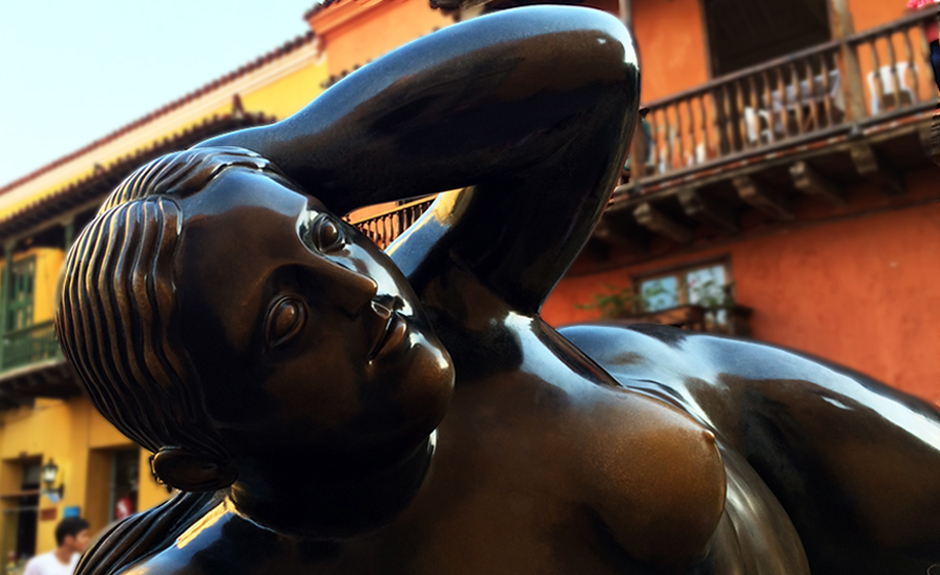
Plaza Santo Domingo – This is one of the most touristy spots in the city. Plaza Santo Domingo is located a block away from Plaza Bolivar. It is made up of the Iglesia de Santo Domingo and a bunch of restaurants that offer outdoor seating. This means that a bunch of young ladies will all work hard to sell you on going to the restaurant they represent. There are a few things I particularly liked about this plaza. First, the Iglesia de Santo Domingo from the mid 1500’s. The church is a popular wedding location, we must have seen a different wedding every night we were there. This plaza is also quite popular for dance troupes, so you get some very inexpensive “dinner & a show”. Just make sure to have a little cash to donate to the performers. Finally, as a good Colombian should, I absolutely fell in love with Gertrudis. Who is she? She’s La gordita de Fernando Botero, Colombia’s most well known visual artist. This Rubenesque reclining nude is made of bronze…it is said that if you rub her breasts, she will bring you luck in love.

Plaza Bolivar – This plaza is always full of people, both tourists and locals. A few spots here deserve their own write up, so they will get it. The plaza surrounds the equestrian statue of Simon Bolivar, Latin America’s George Washington. Grab a seat, buy a fresh coconut and sip it under a tree. At night time, enjoy the nightly dance shows and live concerts. If you’re into museums, check out the Cartagena Gold Museum (tiny, but free to enter). You can also check out the Museum of the Inquisition which has tons of torture devices and more gruesome items. The Cathedral of Cartagena is a nice place to cool down…and if you so wish, check out the sculpture dedicated to Pope John Paul II from his 1986 visit.
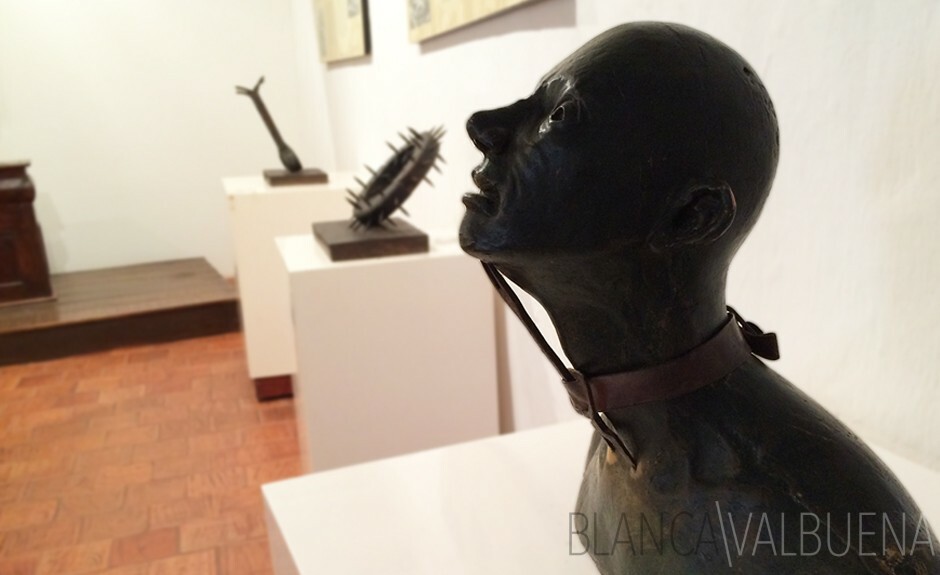
Palacio de la Inquisicion (At Plaza de Bolivar)- This is one crazy museum. It lives in a gorgeous home which served as the court of the Holy Office. It’s not the cheapest museum for what you get, but if you’re an architecture fan like I am…that will make it worth it. A word of warning. There are “guides” in the museum. They don’t cost cheap, and I don’t think they are worth the price. You can pay for them if you want to be entertained, but the museum is not huge, so a guide is not really warranted. That being said, this torture museum really puts things in perspective when you begin to see all the instruments of torture that were used by the church to get people to confess they were witches. There’s some pretty gruesome stuff in there. The thing that freaked me out the most was the Heretics Fork. This device is a double sided fork, that is placed between your sternum and your chin making you super uncomfortable. Basically, you move, you are impaled by the fork. I’m not really sure what kind of person you need to be to come up with this idea, but I’d say a pretty sick one.
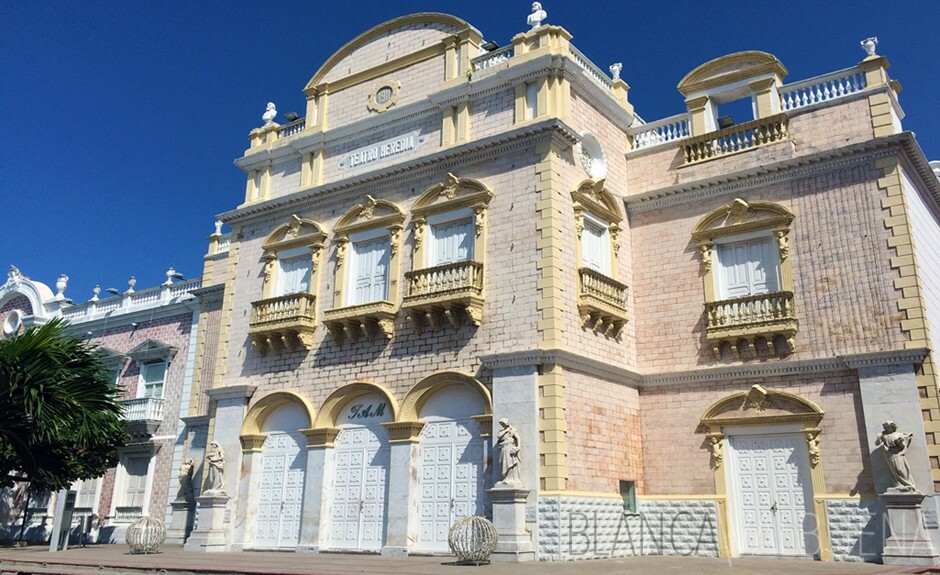
Plaza San Diego – I spent way too much time here, mostly because the ladies at the arepa con huevo stand make the best ones in the city. I think I had one every other day. Seriously – these women are the best in the city, so do not miss them. I loved the square mostly because although there were plenty of tourists in this plaza, you could feel the energy of the locals. Grab a seat at the plaza, enjoy your arepa con huevo and enjoy the music from local musicians ranging from kid rappers, to guitar trios playing boleros, to amateur violinists. When you’re ready to move on, hit up the Institute of the Arts and Sciences, check out las Bovedas, and the Teatro Heredia.
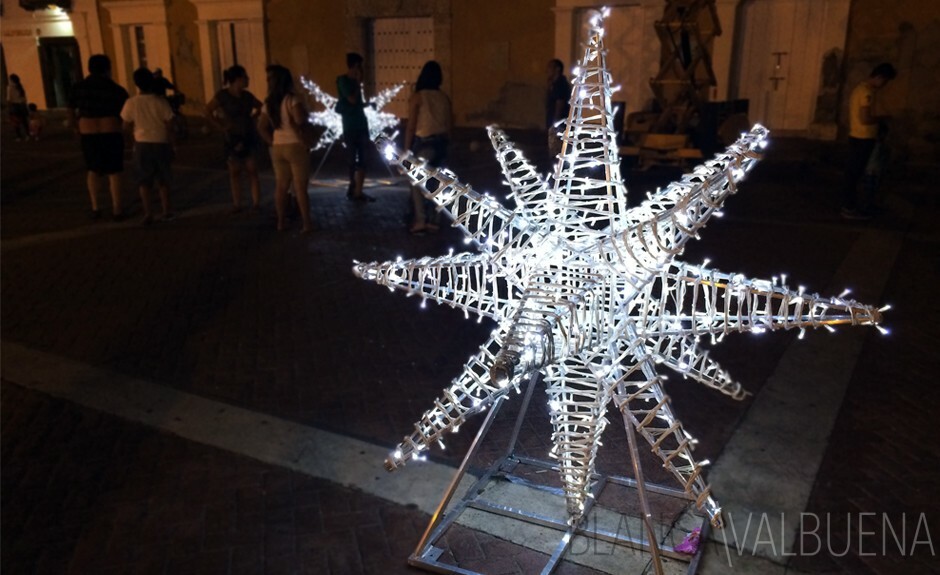
The Clock Tower & Plaza de La Aduana – There are many tiny entrances into the walled city, its most famous is the Puerta del Reloj or Torre del Reloj (Clock Tower). As you go under the clock tower, you will see many artisanal crafts for sale. They’re priced nicely enough, so it’s a nice time to help the local economy. Once you go through the clock tower you will be at the Plaza de los Coches. Yes, you can pick up a carriage ride, but I find them inhumane (many of the horses are ridiculously skinny, and the carriages are made of heavy materials unlike those in New York). Ladies, you are not princesses, stop making believe you are. A quick walk from here, you will find Plaza de la Aduana where Christopher Columbus stands triumphantly over La India Catalina. I’ve got so many issues with this monument, but it does tell you a lot about the history of the city and Latin America. Walk a little more, and you will find yourself at Plaza San Pedro Claver.

Muelle del Pegaso en Cartagena de Indias – As you walk out of the city center through the clock tower, you will encounter the Muelle del Pegaso (dock of the Pegasus) which connects the Center of the old city to Getsemani. It is decorated with multiple pegasus sculptures, and sits in company of the Convention Center and the Camellón de los Martires. It was a lovely spot in December, especially at night when the area would be lit up and vendors sold arepas con queso, cerveza and other treats to locals. You’d often hear music and be entertained by street artists. One night, we ran into the Festival de Pasteles at the Parque Centenario. This was an awesome event. It ran a whole week and local pastel makers competed for the title of the best Pastel of Cartagena. Their pasteles are quite similar to Tamal tolimense. I was in heaven. We went back twice, ate like pigs and had an amazing time. If you want to take a trip to Isla Rosario, you can grab a boat here, but we recommend that you plan this out ahead. A day trip is not worth it. If you head out to Islas Rosario, take at least 3 days.
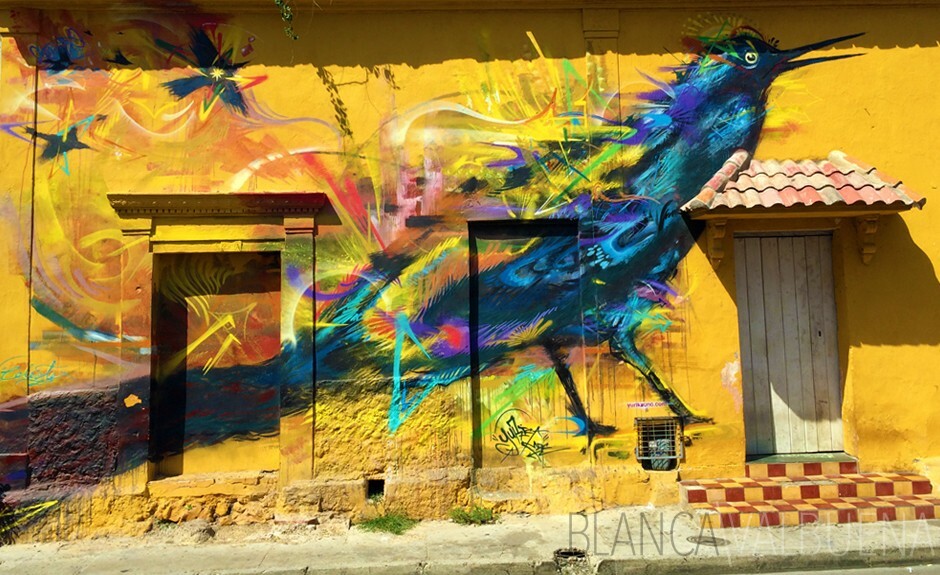
Getsemani – This is now the hippest barrio in Cartagena. It is where independence was first declared and has recently seen a renaissance. It was once known for prostitution, seedy stores and clubs. Now, it is a lovely neighborhood with stunning graffiti and street art, killer restaurants, and is definitely a home for the local Cartageneros. We were there during December and on our nightly walks, we’d see all the people from the neighborhood at the local church singing the novena. There were ton of restaurants, bars, and clubs.
India Catalina – Catalina had it rough. She was kidnapped by the Spanish in the 1500’s and eventually ended up assisting them in the conquest of Colombia. The monument in her name sits on the harbor in between the Castillo de San Felipe and the Old Town.
Castillo de San Felipe de Barajas – Sorry Cartagena, but you gotta up the ante here. This is a stunning site, but you’re missing a ton of opportunities here. Lisbon’s Castelo Sao Jorge is kicking your ass when it comes to defensive castles and it’s not because theirs is better, but because they understand how to use the space to envelop tourists in history and lore. I’m physically healthy and active, and I am a huge history buff…and I did not find this to be the most pleasant experience. The site itself is impressive, but the tourism board is missing out on many opportunities to make money while making visitors happy. Go, but make sure to wear sunscreen (bring extra). Wear sneakers, there is no way up, but walking. Make sure to wear a hat as there are no places to hide from the sun (unless you head into the bovedas – not the most comforting spots around), and make sure to bring a few frozen water bottles. The only shop is all the way at the top of the Castillo, by the time you get there, you will be heat stroked. Cartagena could create a better experience by setting up rest spots (tables, chairs, and umbrellas), guides throughout to talk to you about the history. They could also set up learning centers within the castillo (or at least more signs). Finally, their gift shop sucks. Nice people there, but it’s all nick nacks. That would be the perfect spot to have a small wine/beer/frituras bar and a little music. Lisbon does this, and they do it quite well.

CARTAGENA TRAVEL TIPS
- Sun Protection: The Caribbean sun can be unforgiving. Make sure to wear sunscreen and a hat. Even though I wore SPF 30 on a daily basis, I ended up with a little skin damage. You can also carry around bottles of water, but stuff is so cheap there, I would just buy it on the street.
- Carry small bills: Local vendors (and taxi drivers) will try to get as much out of you as possible. Make sure to carry change so that you don’t end up overpaying for goods and services.
- Stay away from the Emerald Shops: Colombia has great emeralds, but this is not the place to purchase them.
- Do eat on the street: Look for women and men with bags filled with Styrofoam containers. They come out around 11 and will yell “ALMUERZO”. That means lunch. These lunches cost a mere $2USD and usually include coconut rice (yummmy), a green salad, and a protein that can be chicken, or pork. So freaking good. Then grab yourself a coconut from a street vendor to wash it down with.
- Wear White: White reflects heat, so you will stay much cooler. Besides, this is the favorite color of the locals, so you will stick out less.
- Dress nicely: Colombians don’t wear sneakers, and while Cartagena is more relaxed than say Bogota or Medellin, if you wear sneakers or flip flops you will totally stick out. At night time, step up your game. Gentlemen can wear white linen pants with a nice shirt, and ladies can wear a nice Summer dress.
THINGS TO EAT IN CARTAGENA
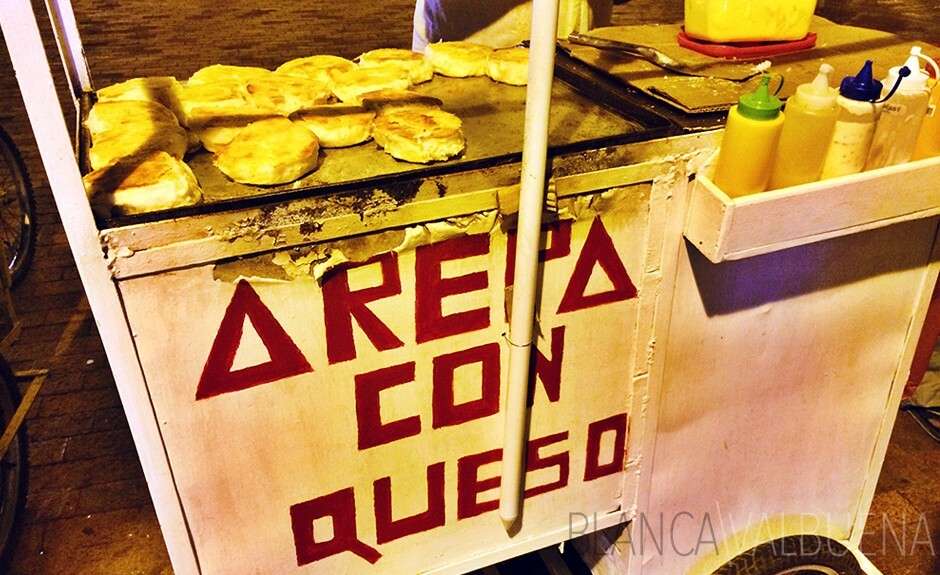
These are not listed in any particular order…but you cannot leave Cartagena without trying these lovely dishes:
- Arepa Con Huevo: My absolute favorite type of arepa. Find the arepa ladies at Plaza San Diego. There are others in the city, but these are better than any restaurant or stall in town. These arepas are made of corn flour, and filled with spiced ground beef and deep fried. Once they cook, they are filled with two eggs and fried again. They are possibly my most favorite indulgence (and they are super cheap). I’m kinda drooling right now.
- Arepa Con Queso: These arepas are thick cheese & cornmeal cakes that are grilled (on butter) and topped with more butter and cheese. They are pungent, delicious, caloric and damn good with a beer. The best ones were at the carts of el Camellón de los Martires.
- Tasting Menu at Restaurante 1621 – Sofitel Santa Clara: It’s expensive for Cartagena, it’s a steal by NYC standards. The cuisine is French-Caribbean and puts the ingredients of Cartagena to the standards of La Technique. The service and wines were also wonderful. We paid $120 USD for dinner for two (two courses and dessert).
- Gelato at Paradiso: I was blown away. Gelateria Paradiso makes everything in-house with the best ingredients available. You can have something traditional like Cookies & Cream, something tropical like Tamarind, or something unusual like Basil. There’s a flavor for everyone.
- Pasteles Cartageneros: I may have loved these because they were so much like Tamales Tolimenses (I may get hurt next time I go to Cartagena for saying this). They are hearty, delicious, and one is enough for two – but I’ve been known to polish one off on my own. They are made or cornmeal which is filled with pork, chicken, beef and a few veggies. The mix is wrapped in a plantain leaf and boiled. If you go in December, ask locals about the Festival de Pasteles. It goes on for a week and you’ll have the chance to taste pasteles from the city’s best Pasteleros.
- Limonada de Coco: Oh yeahhhh…there are few things better in the sweltering Cartagena heat than a delicious Coconut Lemonade. I’m not sure what the hell they do to make this so damn good, but I was ordering these at every restaurant in town.
- Fruit: Fruit is freakin’ delicious in Colombia and Cartagena has a bounty of it. You can get anything from pineapple, papaya, guava, uchuva, nispero, granadillas and much more. If you want to try a good variety, head to one of the squares and buy a salad from the palenqueras. It will cost you very little and you will get a taste of one of each of the fruits at her table.
- Ceviche: You’re at the beach. You better eat seafood. When it comes to ceviche you’ve got plenty of options. You can go to La Cevicheria, but if you really want the Cartagena experience, you need to head to Avenida Venezuela (between the walled city & Getsemani) and check out the Ceviche stands. Amazing ceviche for around $2USD. Just remember to ask for it without ketchup or salsa rosada. Colombians love ketchup on their fish and I find this to be a sacrilege…just something to keep in mind.
- Arroz con Coco: You will be hooked and beg for the recipe. Coconut rice here is served at almost every meal. It’s made with real coconut and panela (basically pure unrefined cane sugar). It somehow works with main courses. Especially fried fish.
- Fried Fish: The fried fish in Cartagena is delicious. Most restaurants will offer whatever is the catch of the day. When you eat it, make sure to relish on the fins. Fried fins taste better than potato chips.
- Patacones con hogao: Fried plantains with hogao…
WHAT TO DO IF YOU GET SICK IN CARTAGENA
Getting sick when you’re traveling sucks. You could go to a hospital in the city, but there’s a much better option. There is a service called AMI. This service is a subscription emergency medical service for locals. How does this help you? If you’re sick, you can call the service and request a doctor. The bad news is that if they’re having a busy night they won’t get to you immediately (and you’ll have to call back until a spot opens up). The good part is that a doctor will come to your hotel/lodgings, check you out there, and prescribe whatever you need. The better part, a visit cost us $90.000 COP (less than $30USD). One note – you will need to call them from a landline or Skype. In Colombia landlines can only call landlines, and mobiles can only call mobiles…weird, I know. Thank you Dr. Ronald for taking good care of us.

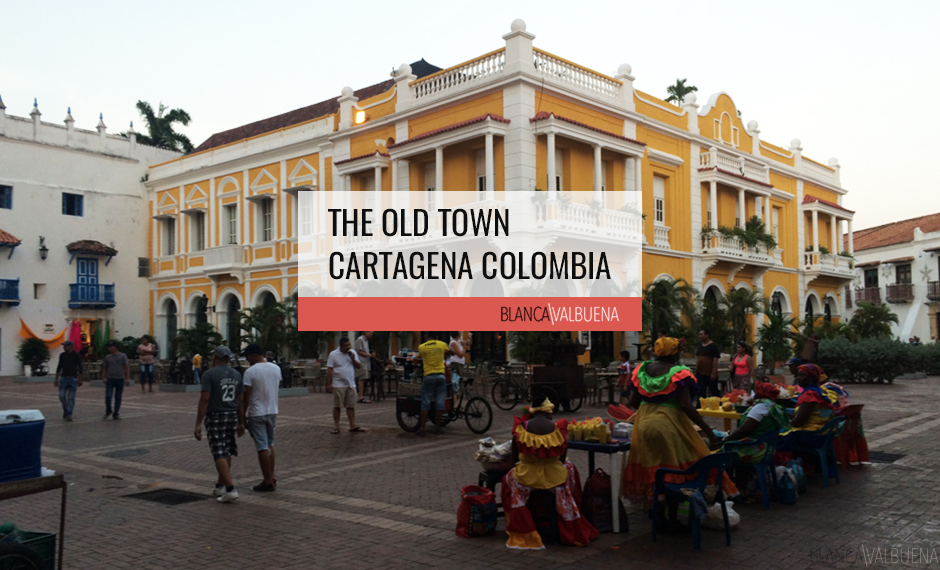
Fantastic information. I have found this only after my return from Colombia. Yet it is helping me to recall places and sights visited in Cartagena. So thanks – I feel like we photographed the exact same things – as probably does every traveller – but yes, thanks for helping me name what I saw. Great article.
Thanks for your note Ness. I always love how a picture can bring a place to mind like you were there yesterday. I’d love to check out your pictures. Drop me a line with your blog or Instagram so I can check them out
Thanks for the in-depth information about Cartagena. We’re headed there February 7th for a week, staying at the beach neighborhood of Los Morros. One question: you love food from street vendors like the Arepos, the fresh fruit and the ceviche. But I’m afraid of risking major distress in the lower tract. In Mexico or Guatemala eating these things would mean a one-way ticket to 72 hours in the bathroom. How safe is the street food?
No sickness from food for me either trip to Colombia (been sick in Mexico). I was told to stay away from shellfish and “street” food at the beach (and I did – so I would not chance that). Arepas, fruit, etc have been fine, even from street vendors in the city. All the ceviche I’ve had has been fish (no shellfish).
Just use precaution. If the person serving looks suspect, the food is probably not safe.
One thing – Colombians add ketchup to their Ceviche – I’m not a fan. Make sure to ask for it “Peruvian Style”. If you have been to Latin America before, chances are you already have a decent amount of Colombian food bacteria.
If you do happen to get sick (I have not both times I visited), you can do a house call on a doctor.
Have an amazing time.
Thank you! this will be very useful from my upcoming trip to Cartagena!
Glad you liked the article. If you need any tips, please don’t hesitate to ask. Have a wonderful weekend.
I just want to say you write some of the best travel articles I have ever seen! So much detail and each one truly makes me want to go to every place you write about!
The grackle wall painting is gorgeous and those cakes look fantastic!
Lots of good eating to be had. I love trying new foods when I travel
Colombia is a wonderful place! I love how friendly everyone is and their accents are the best. I’m glad you had a fun time there!
Sounds like a wonderful place to go! Hopefully I will get the chance to go someday! Thank you for sharing some of its history!
Colombia is one of my dream places! I want to go there so badly!! Cartagena looks amazing and Medellin too!
Lots of historical places to visit and good to know something about it so we already have ideas of their events and culture when we plan to visit Colombia.
They have brilliant architecture! Everything just looks amazing and it’s definitely nice to see these in person. I hope I can travel there with my daughters soon!
What a nice place to learn about Colombia. Hope to visit this place in the future. Thanks for sharing!
Mhaan | http://www.mommyrockininstyle.com
Too much good eating. What’s cool about Cartagena as opposed to other Colombian cities is that you have choice, you can get French, Arabic, Japanese.
It’s my pleasure. Cartagena is a lovely city to visit if you love beaches, history, and food.
You should. It’s wonderful and Colombia is really working on making it better. When you’re ready to go to, don’t hesitate to message me for Cartagena Travel Tips.
Thank you for the kind words. I just want this to be a good resource for those who want to travel better, especially to lesser known and misunderstood places like Colombia.
There is so much to see there. When you do decide to take a Cartagena vacation, do not hesitate to reach out to me for tips.
The city is filled with gorgeous buildings. Besides the history, there is so much to do. I hope you like Cartagena as much as I did.
I hope you do too. Beaches, warm weather and good food can all be found in Cartagena.
I’ve always wanted to go to Columbia. Looks like such great food, fun, and interesting history! I would love to see a dinner and show at the Plaza.
It’s lovely and Colombia is so much safer now than it ever was. Especially Cartagena and Medellin. The dance shows in Cartagena are spectacular.
This place looks lovely, I would love to go see those statues there amazing! The food sounds delicious to! Who dosnt a love a place with good food
I love the buildings. You have some wonderful pictures. The history is interesting.
What a beautiful little place! It looks like such a fabulous spot to travel to and explore. I’m hoping that I’ll get to do more travelling this year. Happy New Year!
The food was ridiculously good. Especially the arepas de huevo, and the ceviche, and the limonada de Coco. In my opinion, Cartagena has the best food in Colombia.
The history is so interesting. All of Colombia is made up of people of all colors and their backgrounds are incredible. It is part of what makes the country (and especially Cartagena) so interesting.
Where are you planning on going Misty? Somewhere tropical?
Cartagena looks like a really great place to visit! The architecture is really beautiful and looks like the city is full of interesting sculptures. I’m sure the food is delicious too!
Beautiful pictures! I would love to tour the museums and try the food. I love the details you provided regarding everything. You left no question unanswered.
It’s wonderful. Beaches, castles, food…I’m kinda bummed I skipped this year
Thanks JcCee. If you do come up with any questions, drop me a line. Cartagena is a wonderful place to visit.
Amazing. The Town is lovely and your pictures are amazing! You made me feel like I was there with you!
This looks like a great place to visit. I love all the photos!
Wonderful pics! Your post made me want some Coconut Lemonade right now Happy New Year!
Happy New Year!
This looks like such a beautiful place to visit! I would love to go and see all of these sights for myself.
Thanks so much for the kind words. Cartagena is such a lovely place (with a dark past) and a bright future. I think it is the perfect place for someone to visit on their first Colombia trip.
It’s really wonderful. There is such a mix of cultures in Cartagena from all the mixing that happened when it was a major port. And now, there is so much food and art…and the beaches. I highly recommend a visit.
Thank you Yonca. Coconut lemonade really is one of the greatest pleasures in life. Could be a good kitchen experiment for you.
Cartagena is wonderful (and still affordable – for now). I seriously recommend that people visit now before it gets more popular and prices rise.
Cartagena has been my dream since I watched Love in the Time of Cholera http://www.imdb.com/title/tt0484740/
You need to go. It’s a wonderful place filled with history. It does have poverty, but the spirit of Cartagena shines through.
Oh Bianca I wish I could! I have a baby son and my wife is pregnant with the second. I’m so happy, but I don’t know when we will be able to travel that far (we live in Europe) with 2 kids

But I do know still all dreams some time come true. Catagena is waiting for me
Good luck to you!
Congratulations to your family! It is definitely a lot more challenging traveling with kids (and Cartagena is quite far from Europe), but you still have amazing beaches here. I’m a big fan of Croatia & France’s beaches. Actually, the water is much nicer there than it is in Cartagena.
I cannot believe that water in the Mediterranean sea is nicer than in the Caribbean.
You see, I’m a romantic soul… I was in Dominicana 4 years ago during my honeymoon. This trip was one of the most unforgettable in my life.
I lied on the beach under the palms reading Christopher Columbus’s diaries and felt like I live 500 years ago and a part of their expedition. Felt like I stepped for the first time onto the ground of the unknown New World (Dominicana (Espaniola) was the first site of the permanent settlement of the Europeans).
I felt the spirit of that epoch. I’m not saying European settlers were angels, of course there were much greediness and cruelty towards the local inhabitants that were turned into slaves and killed massively. But I am sure there were at the same time many people of honor and nobility who tried to stop all the cruelty. Those times were harsh, and now it all part of the history…
I don’t know why, but I tend to romanticize those times and want to visit all New World cities full of that colonial spirit… and Cartagena is one of them.
Depends on where in the Caribbean. Puerto Rico has gorgeous waters in Culebra and Vieques. In Colombia, for gorgeous water, I’d recommend going to San Andres (although it’s gotten very touristy) or Rosario Islands (just make sure that when you go you plan ahead. The waters are lovely, but most tours & boats going out there don’t give the best experiences). The water in Cartagena proper is definitely not up to par.
Love that you’re into history. I’m currently reading Shogun. I love imagining what life was like back then. How were the diaries?
When it comes to the colonial spirit, Cartagena absolutely has it. It’s a lovely place (which is why I go back quite often), so I definitely recommend it
Thank you a lot for your advice!
As you understand from the previous post the diaries were absolutely stunning!
P.S. By the way, Blanca, I’m working on a travel blog at the moment where I would like to feature South America & Caribbeans.
Do you have any great writer (local or non local but living there) with perfect English who would like to write for a blog? Or maybe you personally would like to do this (but I suspect you are quite busy). Also I would like to find a pro photographer who would supply me with authentic colorful photos. I couldn’t find your email anywhere so I post my question to you here (if you don’t mind).
Hey Blanca, did you see my questions?
Sorry I didn’t get back to you earlier, just got over the flu. I don’t know a writer off the top of my head, but check out the travel blogger groups on Facebook. There are tons of bloggers there always looking to collaborate
Have to disagree with your comment on sickness. Just came back after a few days in Cartagena after catching a taxi back to Santa Marta ($200 later) as I was too sick to catch the bus. My son had been ill two days prior to that. We are not newbie travellers and have travelled through Africa, Asia, Europe, India and Mexico with four kids for the past 20 years and have never been sick like that before. I think its true to say you can get sick in any country or any place either from food preparation, cooking time, food storage or just cleanliness in food handling. While we have found no problems in Santa Marta for the past few weeks we definitely did twice in Cartagena.
I’m so sorry to hear you got sick. Were you able to narrow down where exactly it happened? And yes, you can get sick in any country – but I find Colombia has better systems than Mexico when it comes to food safety. I can’t believe they charged you $200 for a taxi. I know it’s expensive but I feel like $150 should have been the max.
Hi Bianca! I was visiting Cartegena a few weeks back and fell in love with some street art that was being sold by a store a few feet away from gelato Paradiso on Calle 36. Would you happen to know how I can contact the store to see if paintings are still available? Thank you!!
You can give them a ring. Last I checked this was the phone number at Gelateria Paradiso 57 5 6604955. They may be able to tell you the name of the store that was selling the art.